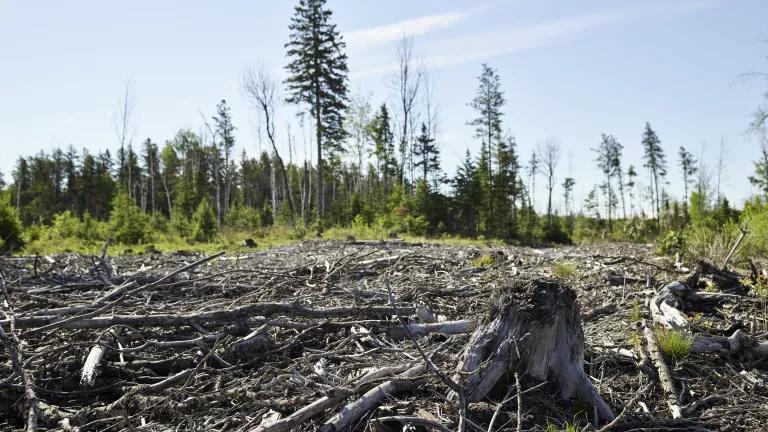P&G’s Vanished Forest Degradation Commitment
P&G's latest policy demonstrates the hollowness of its claims to responsible sourcing.

Clearcut logging in the boreal forest of Canada
River Jordan for NRDC
In its most recent forest sourcing policy, Procter & Gamble (P&G) quietly removed any mention of a claim it spent the last two years touting to investors: that it prohibits forest degradation in its supply chains. The claim first appeared on the heels of a groundbreaking “investor rebellion,” when two-thirds of investors voted in 2020 in favor of a resolution calling on the company to report on how it could eliminate deforestation and forest degradation from its supply chains. The problem was that P&G’s response to investors occurred only on paper. It was not, in fact, prohibiting forest degradation, which led NRDC to file a complaint against the company with the Securities and Exchange Commission (SEC).
Now, without any acknowledgement of the hollowness of its previous position, the claim has disappeared from its recently published “Forest Commodities Policy.” Despite years of public pressure, clear investor directives, and the scientific imperative that P&G stop fueling primary forest degradation, the company’s new sourcing policy removed all references to forest degradation, committing only to prohibit deforestation in its supply chain.
This leaves P&G essentially where it stood during the investor rebellion, as a major driver of the degradation of primary boreal forests in Canada, with significant impacts to the climate and biodiversity. P&G purchases hundreds of thousands of tons of pulp made from boreal trees every year to make its throwaway tissue products, including Charmin toilet paper and Bounty paper towels. Every year, this pulp contributes to the more than 1.3 million acres of boreal forest that’s clearcut in Canada, which puts Canada in the top three countries worldwide for intact forest loss–just behind Russia and Brazil.
In a longstanding international loophole, these impacts do not count as deforestation because, while the forest is cut down, they remain “forests” (i.e. they aren’t converted to new land uses such as agricultural fields or residential neighborhoods). As a result, Canada, which clearcuts more than 1.3 million acres of forest every year, can claim near-zero deforestation.
But, even when regrowth occurs, it often changes the species, structure, and functions of the original forest. Logging in Canada is responsible for about 75 megatonnes of carbon dioxide equivalent, or roughly the same carbon emissions as the entire province of Quebec. Industrial logging occurs on Indigenous Peoples’ lands and in threatened species habitat, contributing to the continued decline of threatened boreal caribou populations. Recently, Environment and Climate Change Canada stated that “protection of the Boreal Caribou’s critical habitat is expected to improve outcomes for 80 other listed species at risk, benefit 90 percent of the bird and mammal species that live in the boreal forest, and provide protection of soil carbon storage hotspots.” Industrial logging in the remaining critical habitat for boreal caribou harms more than just caribou.
Industrial logging in Canada and its accompanying impacts, therefore, would fall under the term forest degradation, which encompasses industrially driven losses in a forest’s ecosystem value. There is widespread consensus that logging in primary forests (i.e. those never logged industrially before), which occurs regularly in Canada, is a form of forest degradation.
When P&G touts measures addressing deforestation, it does nothing to curb the impacts of degradation.
This technicality is why the international scientific community has called for action to limit both deforestation and forest degradation. It’s also why many policymakers, including the European Union and the New York legislature, are now hoping to regulate goods linked to both deforestation and forest degradation. Furthermore, the financial risks associated with forest degradation, like those from deforestation, are clear, which is why in 2020 two-thirds of P&G’s investors voted in favor of a shareholder resolution calling on the company to report on how it could eliminate deforestation and forest degradation jointly.
But in P&G’s latest policy, the company ignores forest degradation entirely and only focuses on prohibiting deforestation in its supply chain. The timing of this step is particularly notable given that last fall, NRDC filed a complaint against P&G with the SEC because the company claimed it already prohibited forest degradation. This claim was misleading, because in its own reporting, it acknowledged its supply chain overlapped with both Intact Forest Landscapes (IFLs are a subset of primary forests) and threatened boreal caribou habitat, which is a good proxy for primary forest areas where boreal caribou live.
As we noted in the complaint, P&G’s claim to prohibit forest degradation had the effect of giving investors the impression the company was doing more to minimize the financial risks associated with degradation than it was actually doing. Over the last 2.5 years, P&G has pointed to its claim to prohibit degradation to position itself as a leader, while still being a major contributor to the problem.
This latest move by the company creates even less clarity about the company's sourcing practices. Even as P&G removed its prohibition on forest degradation from its new policy, the company still claims to prohibit forest degradation in other documents accessible to the public and investors on its website.
The new policy solidifies what NRDC highlighted in its complaint to the SEC: that P&G’s representations to investors were implausible. Any intimations that it acted to address shareholder concerns about the company’s role in driving boreal forest degradation had no basis in what is happening on the ground and disappeared with the stroke of a pen.
P&G needs to stop obfuscating and instead make a real, meaningful commitment to eliminate forest degradation in its supply chain. This is the only way the company can mitigate the risk associated with its boreal supply chain and demonstrate the responsible leadership the company so often claims it has.



